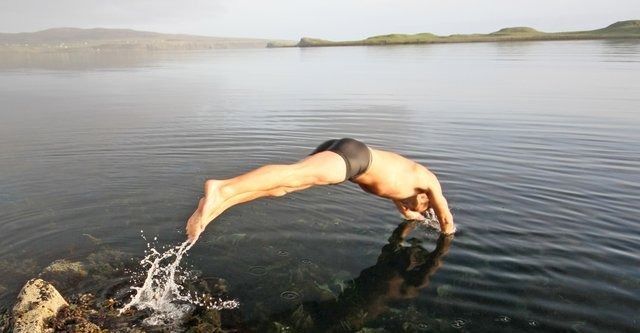
After a blissful summer of swimming everyday in my local river, I am trying to keep dipping through the autumn, and I am going to see how long I can keep it up – perhaps even becoming a real winter swimmer! I almost always combine with a run – somehow a wild swim is its most refreshing when you’re hot and sweaty! But hat’s the best way to winter swim, and is it even good for you?
Benefits
There are lots of benefits to cold water / winter swimming. Cold adaptation is the process by which the body feels less pain in cold water, and also can preserve more heat, but research suggests it also leads to improvements in mood and mental health, and immune functioning, including resistance to colds and flus. Most theories suggest this is due to the sudden release of endorphins (endolphins as Roger Deakin called them) when entering the water, which creates a mood and immune ‘reset’, plus euphoria. Cold water also gets more blood pumping through muscles, due to vasodilation, and also burn calories super fast.
For various review and studies on ‘cold water immersion’ and the science you can read this big review Cold water immersion: kill or cure? from Experimental Physiology. There’s a lot of case study work that supports the theories, such as this study of 21 which showed that cold swimmers had fewer colds than their partners and lots of work in process studying mental health effects. There’s also a great Guardian article here.
How to start winter swimming safely – 10 tips
- It’s important to build cold water exposure (and therefore cold adaptation) regularly and systematically, so keep your regular summer swimming going into autumn, and then beyond – don’t take a big break in autumn and then try and start winter dipping in January
- Decide whether you’re going to be a bare skin plunger or a neoprene swimmer – both are cold, but the former means much quicker, shaper immersions and the latter means you can stay in longer and therefore swim further
- Choose a simple easy place which you can easily commit to and feel safe in.
- Make sure there is a short, simple challenge to complete, such as swimming to the other side of a small river and back, or up to a tree and back, or simply getting in, ducking under, and out. Start with a simple, easy challenge – you may get better at it, but the water is only going to get colder
- Find someone to cold dip with you, both for safety and for peer comradery / moral support
- Whether you wear a full wetsuit or not, booties, gloves and hats can make a big difference and stop pain in the extremities
- It’s easier to go in if you are warm before, and you will last longer with a good store of body temperature. Ending a run with a swim is ideal, but otherwise make sure you arrive feel overly warm
- Don’t stay in too long, shivering is the first stage of hypothermia and hypothermia is NOT good for the immune system. Regular short dips are great, but hypothermia-inducing long swims are not
- Warm up quickly afterwards, with clothes and hot drinks, but be aware of ‘afterdrop’ – body temperature will continue dropping for up to 10 minutes after getting out as cold blood from the extremities returns to the core
- if you are starting out, be cautious of cold water shock, which can create a serious cardio-vascular shock in some people. Don’t just jump in, ease your body in slowly and see how it reacts














